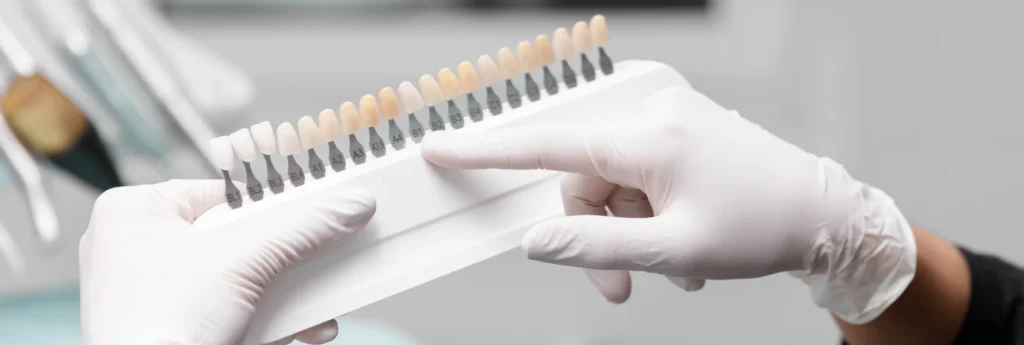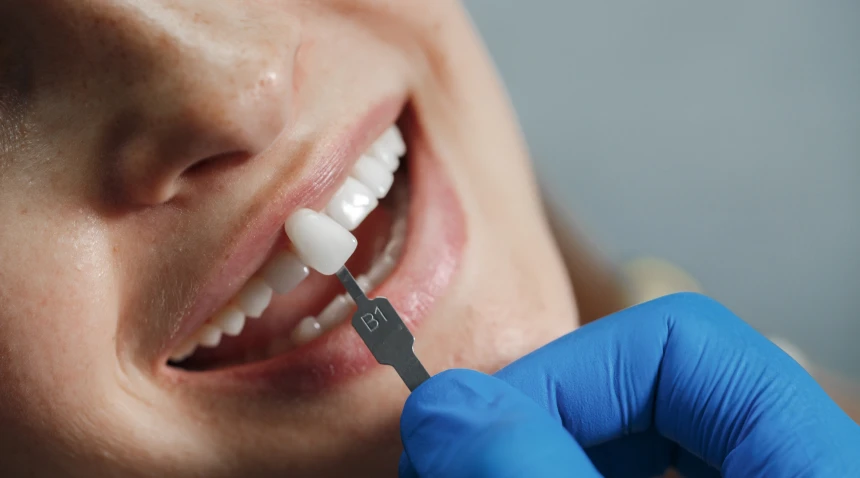Dental veneers are thin shells, usually made of ceramic or composite resin, that the dentist bonds to the visible surface of the teeth. Their main purpose is to enhance the aesthetics of the smile by improving the shape, color, or alignment of the teeth. Unlike a crown, a veneer does not cover the entire tooth, allowing most of the natural structure to be preserved.

Програма ChatGPT сказала:
In addition to their thinness, veneers mimic the natural translucency of enamel, allowing them to blend seamlessly into the smile. They are often an ideal solution when teeth whitening alone is not sufficient or when minor visible imperfections need to be corrected.
In what situations are dental veneers recommended?
Veneers can be suitable in several scenarios. If teeth have lost their natural brightness despite good hygiene, or if they show deep discoloration, this solution may be considered. Likewise, when a tooth is slightly chipped, worn, or too short, veneers can visually correct these imperfections.

Some people also choose veneers to correct minor misalignments without undergoing orthodontic treatment. When teeth are only slightly out of position, veneers can create a more even and refined appearance.
In other cases, veneers are used to close small visible gaps between teeth, known as diastemas.
Програма ChatGPT сказала:
However, veneers should only be placed after a thorough clinical evaluation. An unstable periodontal condition or insufficient oral hygiene may temporarily contraindicate the procedure. Before making any decision, the dentist conducts a comprehensive assessment of the patient’s oral health.
How is the placement of dental veneers performed?
The placement of veneers follows a precise, step-by-step protocol designed to ensure an optimal fit, a natural aesthetic result, and seamless integration into the smile. The process begins with an in-depth consultation and continues over several appointments.
Key stages in the placement of dental veneers:
- Initial consultation: The practitioner listens to the patient’s expectations, examines the oral condition, and takes impressions or photographs to plan the aesthetic project.
- Smile simulation: In some cases, a model or “mock-up” is created to preview the expected result before proceeding with the treatment.
- Tooth preparation: A slight reduction of the enamel may be necessary to accommodate the veneers without adding excess thickness.
- Final impression: This step provides the dental laboratory with accurate data for the custom fabrication of the veneers.
- Veneer try-in: Before final bonding, the dentist checks the shape, shade, and fit of each veneer in the mouth.
- Final bonding: Once approved, the veneers are permanently bonded using a specific dental cement, under carefully controlled isolation to ensure optimal adhesion and durability.
The entire process usually takes two to three appointments, depending on the number of veneers and the complexity of the case. At each stage, the dentist takes time to explain the technical choices and ensure the patient’s comfort. This structured approach guarantees precise placement and long-lasting results, aligned with the patient’s initial expectations.
Expected results
Veneers provide a noticeable enhancement of the smile while preserving the natural look of the teeth. Contrary to popular belief, they do not create a stiff or artificial appearance. On the contrary, when crafted and fitted properly, veneers deliver a subtle, harmonious, and natural-looking result.
Thanks to their thinness and translucency, veneers blend seamlessly with the rest of the teeth. Light reflects off them just like it does on natural enamel, enhancing the lifelike appearance.
In addition, veneers allow for a high level of customization: shape, shade, and size are all tailored to suit the patient’s facial features and aesthetic preferences. They therefore provide a long-lasting cosmetic solution to correct minor imperfections and achieve a balanced, radiant smile.

Maintenance and longevity
Dental veneers can last between 10 and 15 years, or even longer when optimal conditions are met. Their durability depends on several factors. Maintaining good oral hygiene, attending regular check-ups, and limiting the consumption of staining foods and drinks all help preserve their appearance.
Brushing should be done twice a day with a soft-bristled toothbrush and a non-abrasive toothpaste. Using dental floss or interdental brushes is also recommended. It’s best to avoid biting directly into very hard foods such as nuts or hard candies.
Certain habits, such as bruxism (teeth grinding), can affect the stability of veneers. In such cases, a night guard may be prescribed to protect them. Regular dental visits allow the practitioner to monitor overall oral health and ensure the veneers remain intact.
What to consider before choosing veneers
Although veneers are an excellent option for enhancing the smile’s aesthetics, they are not suitable for every situation.

When a tooth has a deep cavity or its structure is too damaged, other restorative treatments are usually more suitable.
It’s also important to understand that getting veneers is a long-term commitment. Once the tooth surface has been prepared, it will always need to be covered with a veneer or an equivalent restoration. In addition, if a veneer becomes detached or is damaged by impact, it will need to be replaced.
That’s why the dentist always takes the time to explain the different available options. They inform the patient about each step, possible limitations, and alternative treatments. This transparency helps the patient move forward with confidence in their aesthetic project.
FAQ – Your Common Questions About Dental Veneers
- Is getting veneers painful?
No. Most patients feel no pain during the procedure. Local anesthesia can be offered if the tooth requires slight preparation. - Do veneers become yellow over time?
Ceramic veneers maintain their color stability for many years. Composite veneers, however, may lose their shine more quickly—especially if you frequently consume tea, coffee, or tobacco. - Do I need to change my diet?
Not necessarily. However, it’s best to limit very colorful or hard foods. This helps preserve the appearance and durability of your veneers. - Can veneers be applied to just one tooth?
Yes. It is entirely possible to place a veneer on a single tooth if the need is localized. However, for a harmonious smile, several teeth may sometimes be involved. - Are veneers reimbursed?
The French Social Security system does not cover this type of procedure, as it is considered cosmetic. Some private health insurances (“mutuelles”) may offer partial reimbursement depending on your plan. - Can veneers be removed later on?
That depends on the type of veneers placed. If the tooth was prepared, a permanent restoration will be required. In the case of “no-prep” veneers, removal may be possible under certain conditions.
Book an appointment at Cabinet Dentaire Mirabeau in Paris 16
Are you considering dental veneers to enhance your smile? At Cabinet dentaire Mirabeau, located in Paris 16, we offer personalized care that respects both your oral health and your aesthetic goals.
Book your appointment online today to start your journey toward a radiant, confident smile.
You may also like: Ceramic crowns